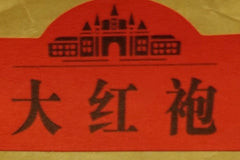The Tea or the Story - What are you buying?

Stories about teas are fun! They can be enchanting, romantic, and sometimes plain funny. It's nice to feel transported to an exotic land in a different era as you sip and enjoy your tea.
But the pragmatic part of me pops up now and then, and ask - Is this tea really all that special? Was I buying the tea or the story? How much extra did I pay for the story?
You probably know my answer. Quite often, I was buying the story.
This epiphany hit me hard in the case of "Big Red Robe," a Wuyi Rock tea from China's Fujian province. I was watching a Taiwan program which explored this famous tea from a journalistic perspective.1
Many of you may already know the story of "Big Red Robe." Let me recap it here briefly.
High up in Wuyi Mountains2, in the northern part of Fujian, there is a precipitous rock cliff upon which 6 tea trees grow. The trees' roots have somehow penetrated the cliff to find support for its growth. As the story goes, during the Song dynasty, a scholar en route to the capital city to take the imperial exam stopped in a nearby village. Falling seriously ill, he was about to give up his dream when someone offered and he drank tea made from these trees. The scholar recovered miraculously, continued his journey, took the examination, and received the highest score and a nice government post. On his way back, the scholar stopped at the rock cliff. He took off his red robe (a most honorable gift presented by the emperor) and wrapped it onto the trees to show his gratitude. Ever since then, the locals referred to these amazing trees and its tea leaves as "Big Red Robe."
How rare are "Big Red Robe" tea leaves? There's another interesting story to this question. According to the program I watched, during Nixon's monumental visit to China in 1972, Mao ZheDong presented him with a small bag of of Big Red Robe. Nixon wasn't overly impressed with this meager-looking gift. Noticing Nixon's displeasure, the premier Zhou EnLai famously remarked that Mao had just gifted Nixon "大半江山" (trans. great half of its Mountains and Rivers). What did Zhou mean? The small bag, containing 150 grams (~5.3 oz) of Big Red Robe tea leaves, contained half of its annual production, around 300 grams in the 1970s.
Historically the Big Red Robe was a "tribute tea". Tribute teas were offered to China's emperors. Back in those days, drinking Big Red Robe tea was sufficient cause for capital punishment.
Fast forward to 2020. What are the Big Red Robe tea leaves we see for sale today? You can be pretty sure it's not tea made from the 6 trees growing on the cliff. A quick Internet search shows that 20 grams of "Big Red Robe" sold for RMB 156,800 (~US$ 22,286) in a 1999 auction. As of 2006, the Big Red Robe trees have been retired, meaning they are no longer plucked for tea making.
What we see now, the Big Red Robe being sold, are made from tea bushes cultivated from the second or third generations of Big Red Robe (e.g. replanted cuttings). Unlike their ancestors, they grow on the ground, not rock cliffs.
As I write, I am sipping away at a cup of Big Red Robe tea. I'm not an expert in Big Red Robe or Wuyi Rock teas, and I am not sure of its grade. To me, the tea tastes pleasant. It looks very dark, so I assume it is quite heavily roasted. Its dominant notes are smokey with a tangy acidity brought out by the roast. It has underlying notes of floral/fruity fragrances, and there is some lingering. Overall a pleasant tea, but not spectacular or unique compared with the Taiwan oolongs I am more familiar with.
Other tea drinking friends have made similar comments. They felt that Big Red Robe is a nice pleasant tea, but like me, felt a little confused. "What is so special about it?"
The answer is ... its story.
The story was used well as a marketing tool. In today's consumption-oriented world, the influence of marketing is everywhere. But being aware of the marketing makes us better-informed consumers.
To be fair, Taiwan has a number of tea stories too. And I am sure other tea-producing countries have their stories to tell. If you are interested, I will be telling a Taiwan story in an upcoming post, this time involving a queen instead of emperors.
NOTES:
- "The Story of Big Red Robe," journalistic report by Ms. Chen, a famous political commentator in Taiwan. The Youtube clip is in Chinese (Mandarin) language.
- WUYI Mountains has been an UNESCO Nature and Cultural Heritage since 1999. Find out more here.